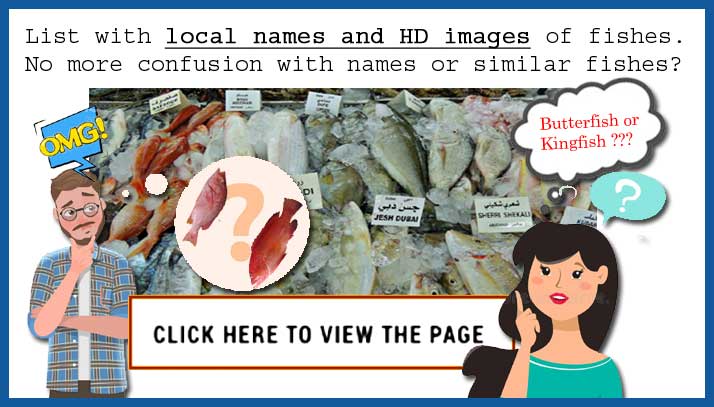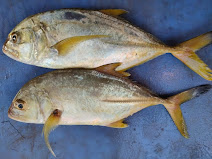Whats the solution? Moderation is the key.
How does this high amoumt of chemical accumulatation happen?
Mercury which ends up in oceans, lakes and other water bodies due to industrial pollution and other sources become methylmercurcy which is harmful. The fish absorbs the methylmercury and accumulate in their bodies, which varies with different fishes based on their age and size. Mercury is not excreted and small fish pick small amount. These small fish are eaten by big fish and the mercurcy accumulates in these bigger fish which is eaten in turn by larger fish, the top predators and big fishes which are mostly caught and consumed by us. It doesn't produce any odor so can't be detected nor does it affect the taste. You can't remove the mercury from the fish so its better to avoid or consume in less portion.
Finding safer seafood and eating safe:
- Eat smaller and younger fish compared to bigger, older fishes.
- Choose different distributors or grocery store. Don’t always eat fish from the same place.
- Eat fish from different rivers and lakes. Chemicals except for mercury, collect in the fish’s fat and liver so cut off all visible fat and avoid eating fatty fish.
- Remove skin or poke holes in the fish’s skin before cooking, to help drain off fats.
- Avoid consumption of head, skin, bones, guts and dark fatty areas.
Any wild-caught fish is preferable or better choice to farmed fish but is very hard to find.
Almost all fish have some mercury, but the largest fish, including tilefish, swordfish, king mackerel, large tuna and shark and certain fresh-water ones, such as pike and bass usually have the high mercury concentrations because they live longer than smaller fish and have more time to accumulate it.
Click here 👆👆👆 for list of 100 popular fishes with Images .
King Mackerel
King Mackerel especially ones caught in the Pacific Ocean are high in mercury. Young children and women who are pregnant or nursing should avoid them completely. King mackerel has one of the highest levels of mercury out of all of the popular saltwater fish. Although not as high in mercury as the king mackerel, the Spanish mackerel also tops the list.
Shark
These predatory fish are extremely high in mercury, which poses threats to humans. But ocean ecosystems suffer, too. Sometimes they are cut up and sold as sea scallops, If you see sea scallops that are a uniform size and shape, you may be looking at shark.
Swordfish
High in mercury, it’s recommended that women of child-bearing age and children steer clear of swordfish
Tilefish
Tilefish caught in the Gulf of Mexico usually have higher mercury levels. It's also sometimes called the rainbow tilefish or the clown of the sea due to its bright blue, green, yellow, and light red colors, though its brightness fades once it's out of the water. Sometimes called golden or white snapper
Bluefin Tuna, Albacore and Bigeye tuna
The bluefin, often referred to as Hon Maguro on sushi menus, Avoid eating it as WWF has put it on endangered species list as their population is depleted and overfished. They also have high level of mercurcy and PCBs. Recommends eating no more than 1 serving per month. Albacore or white tuna has mercury levels that are almost three times higher than the smaller skipjack and most canned white tuna is albacore. A better sushi choice would be katsuo which is skipjack tuna.
Tilapia
Tilapia is one of the most widely consumed fish as its quite cheap.Although wild tilapia are native to Africa, the fish has been introduced throughout the world and is now farmed. It contains very low levels of beneficial omega-3 fatty acids and very high levels of inflammatory omega-6 fatty acids. eating more farmed fish like tilapia is leading to high levels of inflammation in the body which can worsen symptoms of autoimmune disorders and may be linked to chronic conditions like heart disease, cancer and diabetes.
Imported Basa / Swai / Striped Catfish / bocourti / river cobbler/ Pacific dory or creamy dory / Vietnamese catfish or Panga
A cheaper alternative to popular white fish such as cod or haddock the fish called pangasius or swai fish were so contaminated that several environmental organisations concerned with marine ecosystems have raised concerns about basa. These farming method results in fish swimming in waste and sludge. They are also commonly treated with antibiotics, in addition to pesticides and disinfectants. Although cheap, just avoid it. Sometimes pangasius is described, legally, simply as "fish", as in "fish and chips" instead of Cod
Grouper
Grouper is a predatory fish, this means they relatively have higher mercury or other heavy metal content. And that goes for all species of Grouper. The grouper is a bottom eating fish with light, meat. it's not recommended for young children. Grouper is also the common target of seafood fraud mislabeled with cheaper fishes like Basa, whitefin weakfish or king mackerel
Chilean Seabass
Patagonia toothfish or the Chilean seabass aside from overfishing, its high mercury levels are also problematic. Harvesting the fish from Chile is also plagued by poor management and bycatch problems.
Orange Roughy
Generally known as “slimehead” or deep sea perch, due to slow reproduction and long life (sometimes lives 100 to 150 years or more ) its overfished and the long life means it has high level of mercury accumulated.
Salmon (Farmed)
Farmed salmons are raised in tightly packed spaces often rife with parasites and diseases and given antibiotics to combat these diseases, thus making it to the list of fish to avoid.
Atlantic Cod
Due to overfishing of Atlantic Cod in recent years there is food web collapse, and the species is currently considered vulnerable to extinction.
Weakfish
Weakfish also referred as sea trout is bad for the environment and you.
Atlantic Flatfish (Atlantic halibut, flounder and sole)
This fish grows slowly living as long as 50 years , so its susceptible to overfishing and high contamination levels, these flatfish species have secured their slot on the list of fish you should never eat.
Eel
It is slow to mature and has been overfished in many parts of the world, bringing some populations to collapse. Most consumers see it in sushi, but it is often high in PCBs and mercury, eels tend to readily absorb and store harmful chemicals .
Farmed Shrimp
Farmed shrimp accounts for about 90 percent of the shrimp we consume. Shrimp farm ponds are also treated with harmful chemicals and pesticides such as malachite green, which can have detrimental effects on health. Italian researchers discovered that a food additive used to prevent discoloration in shrimp could reduce sperm count in men and increase breast cancer risk in women.
Cobia
Cobia is a delicious saltwater fish that sadly can soak up a lot of mercury
Greater Amberjacks
These fishes although very delicious and buttery also have high mercury level. Consume less portion or in moderation.
Marlin
Due to overfishing and high mercury level, its a fish better off the menu.
Jack crevalle
Jack crevalle can actually be poisonous to eat due to the threat of ciguatera poisoning which harmless to fish, it is known to be really harmful to humans, so be careful.
Small fish are better
Avoid large fish
Fats should be removed
Eat broiled or grilled fish and allow fats to drain off
and Moderation is the key.
Continue Reading...






 Worst fishes not safe to eat ?
Worst fishes not safe to eat ?








